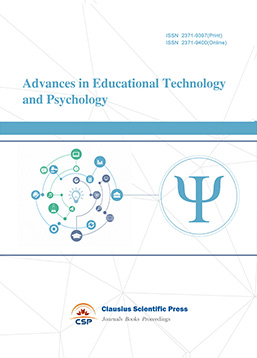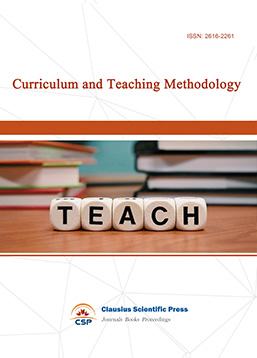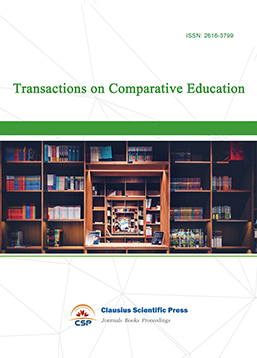The Relationship between Thought Suppression and Psychological Resilience
DOI: 10.23977/appep.2025.060105 | Downloads: 25 | Views: 893
Author(s)
Min Ou 1, Yiming Wang 2
Affiliation(s)
1 School of Psychology, Northwest Normal University, Lanzhou, China
2 School of Chemical Engineering, Northwest Minzu University, Lanzhou, China
Corresponding Author
Min OuABSTRACT
This study explored the relationship between thought suppression and psychological resilience. Using a questionnaire approach, a survey was conducted on a sample of adults in Gansu Province, utilizing a self-developed demographic questionnaire, the Brief Resilience Scale, and the White Bear Suppression Inventory. A total of 272 responses were collected online and analyzed using SPSS 26.0. The results indicated a significant negative correlation between thought suppression and psychological resilience (ps < 0.001), with psychological resilience negatively predicting thought suppression (β = -0.819, t = -19.874, p < 0.001). Higher levels of psychological resilience were associated with lower levels of thought suppression. These findings suggest that individuals should focus on enhancing their psychological resilience to reduce tendencies for thought suppression, promoting overall mental and physical well-being.
KEYWORDS
Thought Suppression; Psychological Resilience; Mental HealthCITE THIS PAPER
Min Ou, Yiming Wang, The Relationship between Thought Suppression and Psychological Resilience. Applied & Educational Psychology (2025) Vol. 6: 29-35. DOI: http://dx.doi.org/10.23977/appep.2025.060105.
REFERENCES
[1] Wegner, D. M. Setting free the bears: escape from thought suppression. American Psychologist, 2011, 66(8), 671. https://doi.org/10.1037/a0024985
[2] Wegner, D. M., Schneider, D. J., Carter, S. R., & White, T. L. Paradoxical effects of thought suppression. Journal of personality and social psychology, 1987, 53(1), 5. 10.1037//0022-3514.53.1.5
[3] Purdon, C. Thought suppression. Oxford University Press, 2020. http://hdl.handle.net/10012/17108
[4] Lavy, E. H., & Van den Hout, M. A. Thought suppression induces intrusions. Behavioural and Cognitive Psychotherapy, 1990, 18(4), 251-258. https://doi.org/10.1017/S0141347300010351
[5] Wegner, D. M. How to think, say, or do precisely the worst thing for any occasion. Science, 2009, 325(5936), 48-50. DOI: 10.1126/science.1167346
[6] Wenzlaff, R. M., & Wegner, D. M. Thought suppression. Annual review of psychology, 2000, 51(1), 59-91. https://doi.org/10.1146/annurev.psych.51.1.59
[7] Mamat, Z., & Anderson, M. C. Improving mental health by training the suppression of unwanted thoughts. Science Advances, 2023, (38), eadh5292. DOI: 10.1126/sciadv.adh5292
[8] Cowan, C. S., Wong, S. F., & Le, L. Rethinking the role of thought suppression in psychological models and treatment. Journal of Neuroscience, 2017, 37(47), 11293-11295. 10.1523/JNEUROSCI.2511-17.2017
[9] Colombo, D., Wrzesien, M., & Baños, R. M. Recalling Tough Times: Exploring the Effect of Acceptance on Autobiographical Memory in Daily Life. Mindfulness, 2024, 15(3), 601-615. 10.1007/s12671-024-02301-0
[10] Cowan, C. S., Wong, S. F., & Le, L. Rethinking the role of thought suppression in psychological models and treatment. Journal of Neuroscience, 2017,37(47), 11293-11295. 10.1523/JNEUROSCI.2511-17.2017
[11] Baer, R. A., Peters, J. R., Eisenlohr-Moul, T. A., Geiger, P. J., & Sauer, S. E. Emotion-related cognitive processes in borderline personality disorder: a review of the empirical literature. Clinical psychology review, 2012,32(5), 359-369. https://doi.org/10.1016/j.cpr.2012.03.002
[12] Wang, Y., Zhu, Z., Hu, J., Schiller, D., & Li, J. Active suppression prevents the return of threat memory in humans. Communications biology, 2021,4(1),609. 10.1038/s42003-021-02120-2
[13] Wegner, D. M., & Zanakos, S. Chronic thought suppression. Journal of personality, 1994,62(4),615-640. https://doi.org/10.1111/j.1467-6494.1994.tb00311.x
[14] Fletcher, D., & Sarkar, M. Psychological resilience. European psychologist. 2013. https://doi.org/10.1027/1016-9040/a000124
[15] Afek, A., Ben-Avraham, R., Davidov, A., Berezin Cohen, N., Ben Yehuda, A., Gilboa, Y., & Nahum, M. Psychological resilience, mental health, and inhibitory control among youth and young adults under stress. Frontiers in Psychiatry, 2021,11, 608588. https://doi.org/10.3389/fpsyt.2020.608588
[16] Pan, L., Zhao, J., Pang, M., Wang, J., Zhou, Y., Chen, R., ... & Kong, F. Addressing psychological resilience and its determinants among university students during the COVID-19 pandemic: a three-wave longitudinal study in Shandong Province, China. BMC psychiatry, 2024, 24(1), 823. 10.1186/s12888-024-06175-3
[17] Tugade, M. M., & Fredrickson, B. L. Resilient individuals use positive emotions to bounce back from negative emotional experiences. Journal of personality and social psychology, 2004, 86(2), 320. 10.1037/0022-3514.86.2.320
[18] Wu, Y., Yu, W., Wu, X., Wan, H., Wang, Y., & Lu, G. Psychological resilience and positive coping styles among Chinese undergraduate students: a cross-sectional study. BMC psychology, 2020, 8, 1-11.10.1186/s40359-020-00444-y
[19] Connor, K. M., & Davidson, J. R. Development of a new resilience scale: The Connor‐Davidson resilience scale (CD‐RISC). Depression and anxiety, 2003, 18(2), 76-82. https://doi.org/10.1002/da.10113
[20] Campbell‐Sills, L., & Stein, M. B. Psychometric analysis and refinement of the connor–davidson resilience scale (CD‐RISC): Validation of a 10‐item measure of resilience. Journal of Traumatic Stress: Official Publication of The International Society for Traumatic Stress Studies, 2007, 20(6), 1019-1028. https://doi.org/10.1002/jts.20271
[21] Wang, L., Shi, Z., Zhang, Y., & Zhang, Z. Psychometric properties of the 10‐item Connor–Davidson Resilience Scale in Chinese earthquake victims. Psychiatry and clinical neurosciences, 2010, 64(5), 499-504. https://doi.org/ 10.1111/j. 1440-1819.2010.02130.x
[22] Zhou, L., Chen, J., & Su, L. Y. A study on the reliability and validity of the Chinese version of the White Bear Suppression Inventory. Chinese Journal of Clinical Psychology, 2012, 20(03), 343-345.
[23] Salvagioni, D. A. J., Melanda, F. N., Mesas, A. E., González, A. D., Gabani, F. L., & Andrade, S. M. D. Physical, psychological and occupational consequences of job burnout: A systematic review of prospective studies. PloS one, 2017, 12(10), e0185781.https://doi.org/10.1371/journal.pone.0185781
[24] Wang, Y. X., Cai, C., Zhu, Y. X., Shi, W. L., Cheng, B., Li, C. Y., & Shi, C. Q. Family burden and psychological distress among Chinese caregivers of elderly people with dementia: a moderated mediation model. BMC nursing, 2024, 23(1), 723. 10.1186/s12912-024-02382-1
[25] D'Oliveira, T. C., & Persico, L. Workplace isolation, loneliness and wellbeing at work: The mediating role of task interdependence and supportive behaviours. Applied Ergonomics, 2023, 106, 103894. https://doi.org/10.1016/j. apergo. 2022. 103894
| Downloads: | 16728 |
|---|---|
| Visits: | 601326 |

 Download as PDF
Download as PDF



